Old Cars Weekly: Vanderbilt Family’s 1938 Brewster Ford V-8
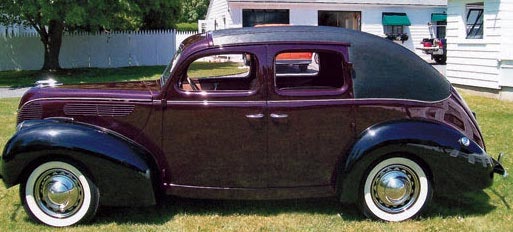
Angelos Van Bogart has written an excellent article in Old Cars Weekly describing the last Brewster Ford which was owned by a member of the Vanderbilt Family.
VanderbiltCupRaces.com and our newsletter received a neat shout-out in the blog post:
"A group of hobbyists keep the memory of the Vanderbilt Cup Races alive on an active website and through a regular electronic newsletter. Learn more about the organization and the races at www.vanderbiltcupraces.com."
Enjoy,
Howard Kroplick
The last Brewster Ford
March 26, 2012
There are more mods than meet the eye in the Vanderbilts’ former 1938 Ford V-8
This 1938 Ford DeLuxe V-8 is believed to have been modified under the Brewster name for the Vanderbilt family and wears several unique features.
By Angelo Van Bogart
Photos by G. Steven Willey
After their financial resources, the Vanderbilts are known for automobiles — both racing them and owning them. In 1904, William Kissam Vanderbilt II founded the Vanderbilt Cup, a race that attracted international competition to Long Island, N.Y. The race lasted through 1906, after which Vanderbilt built a parkway that could double as a race course to re-start the competition beginning in 1908.
In addition to their unique dedication to racing the automobile, the family had uniquely fine taste when it came to selecting chariots. Grand names such as Packard famously occupied the Vanderbilt family members’ carriage houses and garages, many of these cars carrying expensive and plush coachwork. However, that coachwork wasn’t always reserved for a Vanderbilt Packard, as this 1938 Ford Deluxe proves.
Upon reading about a Vanderbilt family member’s 1934 Packard Rollston town car in Old Cars Weekly, reader G. Steven Willey submitted these photographs of an unusual Ford once owned by a line of the Vanderbilt family. The car is now owned by Willey’s friends, who are Rhode Island neighbors to the Vanderbilts. To protect the wishes of the current owners, we will not identify them. However, Willey was able to offer some insight into the unusual Ford from information the owners provided before he inspected it during the summer of 2010.
“When Mrs. Vanderbilt died, [the current owner] went over the house and there was a line out the door of people wanting to buy items from the home,” Willey said. “The people in the home said the car will be sold to [the current owner] and she has had it ever since,” Willey said. The sale occurred in the 1960s.
Willey said the modifications to the stock Ford body were undertaken by Brewster, a coachbuilder well known for crafting bodies for Rolls-Royce automobiles. However, Brewster went out of business in 1936, and in 1937, John S. Inskip, a former Brewster vice-president of sales, purchased the remains of the company. Inskip’s new company continued to sell automobiles and bodies it built. It’s believed Inskip used the Brewster name when his company modified this Ford, perhaps treating it as a continuation of the 1934-’35 Brewster Ford town cars, those very formal Ford V-8s famous for their heart-shaped grille. Although this 1938 Ford does not employ as many unique features as an earlier Brewster Ford, it does have many subtle features that make it exclusive.
“They took the running boards off it, because during that period of time, hobos would jump on cars with running boards and try to ride on the car, so he had Brewster remove the running boards so that would not happen,” Willey said. “Of course, it’s also the Vanderbilt colors — the Royal claret and black — so it was obviously a Vanderbilt car if you knew that those were the family colors.”
On the outside, the Ford is crowned with a top covering that begins several inches behind the windshield and extends across the roof and down to the top of the deck lid. The lower rear edge of the roof covering is neatly trimmed to match the car’s beltline pinstripe.
Inside, the Ford is plusher than a production DeLuxe model with upholstered panels over the blanked-out rear side windows, each carrying a small lamp, plus several other appointments that add to its individuality.
“It has a braided rope in the back seat, which is nautical because, of course, the Vanderbilts were a very nautical family,” Willey said. The Ford also has a division window operated with a crank on the occasion it was chauffeur-driven.
The plush broadcloth rear seat is flanked by blanked-out rear window panels carrying small lamps.
A division trimmed with wood and a nautical-style braided rope separates the driver's compartment from the passenger compartment.
Willey said the current owners had the Ford repainted during their 40-plus years of ownership, but the car is otherwise original and in fine condition. The Ford was also in fine running condition when Willey inspected it during 2010, so it’s possible some readers have seen this handsome Ford on Rhode Island’s roads. If you are among them and can provide more details, write to OCW — we’d love to fill in any gaps.
More info: Vanderbilt Cup Races
A group of hobbyists keep the memory of the Vanderbilt Cup Races alive on an active website and through a regular electronic newsletter. Learn more about the organization and the races at www.vanderbiltcupraces.com.
More info: Early Ford V-8 Club
The Early Ford V-8 Club of America is an international organization that honors 1932-’53 Ford, Lincoln, Mercury, commercial vehicles, tractors and other Ford-powered vehicles built with 4-, 6-, 8-, and 12-cylinder engines produced by Ford Motor Co.
Resources
The Early Ford V-8 Club of America
P.O. Box 1715
Maple Grove, MN 55311
www.earlyfordv8.org
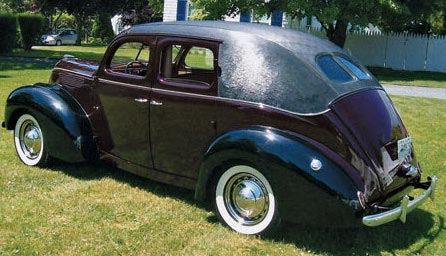
A roof covering that blanks out the rear side windows caps off the Vanderbilt 1938 Ford and adds to its elegance. The car lacks running boards and wears the fully plated wheel covers.
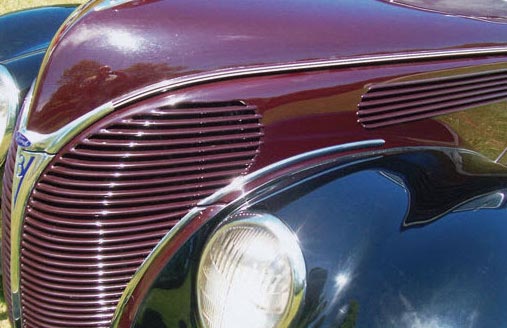
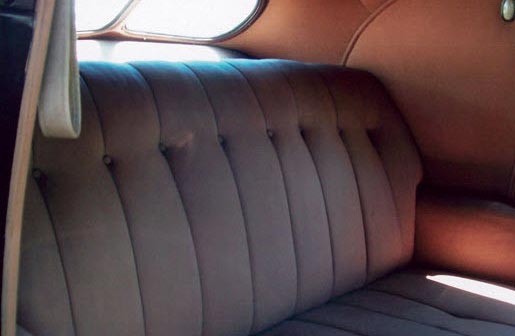
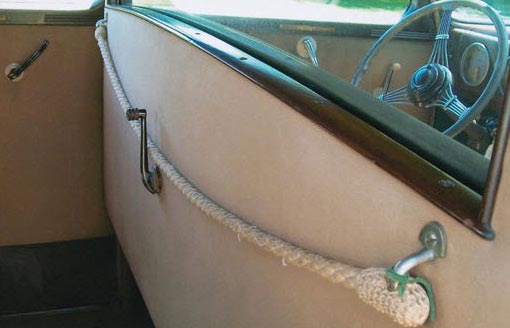

Comments
These padded top conversions were not that uncommon in the early post depression era. Derham did many of them. At one point in 1938 or 39 Bob Gregorie did one about like this in the Ford styling department for Edsel Ford. Edsel drove it home for a week or so, thought it was an interesting idea. He returned to Ford Engineering and they gave it away.
Inskip was still doing re-bodying of prewar Rolls Royces into the 1950 at their body shop. Many of these cars have survived.
I thoroughly enjoy the articles on these one of a kind classical autos. Also the old parkway and races.
Thank you!
Before we moved to Woodstock, NY in 1969, I remember seeing a 1934 Ford Brewster around in Southampton, NY. As I recall, It was a greyish tan with beautiful custom woodwork inside the rear passenger area. It was in excellent shape. Perhaps it’s still there. I haven’t been back since moving from Long Island. Has anyone seen it?
Having grown up on Long Island’s south shore in the ‘50s, I’m sentimental of cars like this. As a young teenager, with an itch to drive the nicer cars than our family Ford, I found a way to do it legally.
Working as a caddy at one of the country clubs, I washed and parked many of the cars owned by the members. The nicer ones included a ‘55 T-Bird, black convertible, but goshdarn, it had an automatic. At an evening function, I’d also get to valet park, where some of the more challenging ones appeared…(Remember, I was 14) including a large British sedan, silver, with a dashboard row of toggle switches I was stymied by. Where to start it?
Ahh, the memories are still with me as it was there I cut my teeth on the cars built with style and panache!